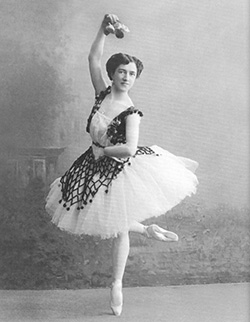Agrippina Vaganova & The Vaganova Method
 Agrippina Vaganova was born in St. Petersburg, Russia in 1879. As a dancer with the Imperial Ballet, later the Mariinsky, she was known as the “queen of variation” and also well known teacher and choreographer.
Agrippina Vaganova was born in St. Petersburg, Russia in 1879. As a dancer with the Imperial Ballet, later the Mariinsky, she was known as the “queen of variation” and also well known teacher and choreographer.
She created an instructional system that became known to the world as the standard for ballet instruction: The Vaganova Method. The Vaganova Method leaves a dancer with a strong lower back, plasticity of the arms and endurance in the muscles for the most difficult movements. The training system is designed to involve the whole body in every movement, with equal attention paid to the upper body, legs and feet. Vaganova believed that this approach increases consciousness of the body, thus creating a harmony of movement and greater expressive range.
The steps in Vaganova’s syllabus builds on a carefully developed progression in which the “basic” or “preparatory” forms are mastered before the dancer moves on to more difficult forms. The syllabus is founded upon the idea that when a dancer is introduced to a step, he or she will have developed the correct strength in foundation in order for their steps and movements to be successful. It is understood that this strength-building requires time and consistent hard work.
Overall, the Vaganova method is a very precise technique where dancers are taught to be highly aware of every part of the body. Vaganova-trained dancers possess a thorough attention to detail; they are sophisticated dancers with unique elegance, cleanliness, and strength.
The Vaganova Academy, which was once the old Imperial Ballet School, has taught such dancers as Anna Pavlova, Vaslav Nijinsky, Rudolf Nureyev, Natalia Makarova, Mikhail Baryshnikov and George Balanchine.
